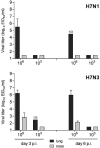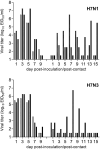Mammalian pathogenicity and transmissibility of low pathogenic avian influenza H7N1 and H7N3 viruses isolated from North America in 2018
- PMID: 32449503
- PMCID: PMC8284977
- DOI: 10.1080/22221751.2020.1764396
Mammalian pathogenicity and transmissibility of low pathogenic avian influenza H7N1 and H7N3 viruses isolated from North America in 2018
Abstract
ABSTRACTLow pathogenic avian influenza (LPAI) H7 subtype viruses are infrequently, but persistently, associated with outbreaks in poultry in North America. These LPAI outbreaks provide opportunities for the virus to develop enhanced virulence and transmissibility in mammals and have previously resulted in both occasional acquisition of a highly pathogenic avian influenza (HPAI) phenotype in birds and sporadic cases of human infection. Two notable LPAI H7 subtype viruses caused outbreaks in 2018 in North America: LPAI H7N1 virus in chickens and turkeys, representing the first confirmed H7N1 infection in poultry farms in the United States, and LPAI H7N3 virus in turkeys, a virus subtype often associated with LPAI-to-HPAI phenotypes. Here, we investigated the replication capacity of representative viruses from these outbreaks in human respiratory tract cells and mammalian pathogenicity and transmissibility in the mouse and ferret models. We found that the LPAI H7 viruses replicated to high titre in human cells, reaching mean peak titres generally comparable to HPAI H7 viruses. Replication was efficient in both mammalian species, causing mild infection, with virus primarily limited to respiratory tract tissues. The H7 viruses demonstrated a capacity to transmit to naïve ferrets in a direct contact setting. These data support the need to perform routine risk assessments of LPAI H7 subtype viruses, even in the absence of confirmed human infection.
Keywords: Ferret; LPAI; avian; influenza; mouse; transmission.
Conflict of interest statement
No potential conflict of interest was reported by the author(s).
Figures




Similar articles
-
Pathogenesis and Transmission Assessments of Two H7N8 Influenza A Viruses Recently Isolated from Turkey Farms in Indiana Using Mouse and Ferret Models.J Virol. 2016 Nov 14;90(23):10936-10944. doi: 10.1128/JVI.01646-16. Print 2016 Dec 1. J Virol. 2016. PMID: 27681133 Free PMC article.
-
Emergence and Selection of a Highly Pathogenic Avian Influenza H7N3 Virus.J Virol. 2020 Mar 31;94(8):e01818-19. doi: 10.1128/JVI.01818-19. Print 2020 Mar 31. J Virol. 2020. PMID: 31969434 Free PMC article.
-
Pathogenicity and Transmissibility of North American H7 Low Pathogenic Avian Influenza Viruses in Chickens and Turkeys.Viruses. 2019 Feb 16;11(2):163. doi: 10.3390/v11020163. Viruses. 2019. PMID: 30781528 Free PMC article.
-
Ecology and epidemiology of avian influenza in North and South America.Dev Biol (Basel). 2006;124:37-44. Dev Biol (Basel). 2006. PMID: 16447492 Review.
-
The Arrival of Highly Pathogenic Avian Influenza Viruses in North America, Ensuing Epizootics in Poultry and Dairy Farms and Difficulties in Scientific Naming.Microb Biotechnol. 2024 Dec;17(12):e70062. doi: 10.1111/1751-7915.70062. Microb Biotechnol. 2024. PMID: 39641589 Free PMC article. Review.
Cited by
-
Human infection with a reassortment avian influenza A H3N8 virus: an epidemiological investigation study.Nat Commun. 2022 Nov 10;13(1):6817. doi: 10.1038/s41467-022-34601-1. Nat Commun. 2022. PMID: 36357398 Free PMC article.
-
Genetic Characterization and Pathogenicity of H7N7 and H7N9 Avian Influenza Viruses Isolated from South Korea.Viruses. 2021 Oct 13;13(10):2057. doi: 10.3390/v13102057. Viruses. 2021. PMID: 34696486 Free PMC article.
-
Utility of Human In Vitro Data in Risk Assessments of Influenza A Virus Using the Ferret Model.J Virol. 2023 Jan 31;97(1):e0153622. doi: 10.1128/jvi.01536-22. Epub 2023 Jan 5. J Virol. 2023. PMID: 36602361 Free PMC article.
-
Avian Influenza in Wild Birds and Poultry: Dissemination Pathways, Monitoring Methods, and Virus Ecology.Pathogens. 2021 May 20;10(5):630. doi: 10.3390/pathogens10050630. Pathogens. 2021. PMID: 34065291 Free PMC article. Review.
-
Kinetics and magnitude of viral RNA shedding as indicators for Influenza A virus transmissibility in ferrets.Commun Biol. 2023 Jan 23;6(1):90. doi: 10.1038/s42003-023-04459-0. Commun Biol. 2023. PMID: 36690690 Free PMC article.
References
-
- Lee DH, Torchetti MK, Killian ML, et al. . Deep sequencing of H7N8 avian influenza viruses from surveillance zone supports H7N8 high pathogenicity avian influenza was limited to a single outbreak farm in Indiana during 2016. Virology. 2017;507:216–219. doi: 10.1016/j.virol.2017.04.025 - DOI - PubMed
MeSH terms
LinkOut - more resources
Full Text Sources
Medical
